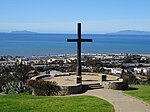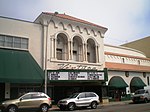Emmanuel Franz House
Buildings and structures in Ventura, CaliforniaHouses completed in 1891Houses in Ventura County, CaliforniaHouses on the National Register of Historic Places in CaliforniaItalianate architecture in California ... and 4 more
National Register of Historic Places in Ventura, CaliforniaSouthern California Registered Historic Place stubsVentura County, California geography stubsVictorian architecture in California

The Emmanuel Franz House is an Italianate style Victorian historical residence located within downtown Ventura, in coastal Ventura County, California.The wood and brick Franz House was built from 1879 to 1891. The house has an interesting front stoop and widow's watch.The City Council of Ventura designated this building Historic Landmark Number 21 by resolution on March 29, 1976. The house was listed in 1982 on the National Register of Historic Places.
Excerpt from the Wikipedia article Emmanuel Franz House (License: CC BY-SA 3.0, Authors, Images).Emmanuel Franz House
North Oak Street, Ventura
Geographical coordinates (GPS) Address Nearby Places Show on map
Geographical coordinates (GPS)
| Latitude | Longitude |
|---|---|
| N 34.281277777778 ° | E -119.29486111111 ° |
Address
North Oak Street
93001 Ventura
California, United States
Open on Google Maps











